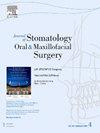Alternative to the cervical approach for total temporomandibular joint prosthesis: A case series
IF 1.8
3区 医学
Q2 DENTISTRY, ORAL SURGERY & MEDICINE
Journal of Stomatology Oral and Maxillofacial Surgery
Pub Date : 2025-03-14
DOI:10.1016/j.jormas.2025.102314
引用次数: 0
Abstract
Purpose
New-generation total temporomandibular joint prostheses have demonstrated their efficacy and low morbidity. However, their implantation requires a dual external approach, which can result in significant aesthetic and functional sequelae. The authors have therefore developed an alternative technique that avoids the cervical route.
Materials and methods
The authors describe their technique for implanting a temporomandibular joint prosthesis using a combination of pre-auricular and intraoral approaches. They share the outcomes from a series of 16 patients treated with this technique, reporting complications as well as improvements in range of motion (ROM) and patient-reported outcomes regarding pain, eating ability, and overall satisfaction.
Results
A total of 16 patients and 22 prostheses were included. The functional results demonstrated a significant average increase in ROM of 34.4 mm (p < 0.001), a one-point reduction on the visual analogue scale (VAS) for pain (p = 0.19), and a 1.1-point improvement in feeding ability on our scale of 1 to 4 (p < 0.001). Complications included one case of transient facial paralysis with complete recovery, and one case of implant-related infection requiring removal of the prosthesis.
Discussion
this technique appears to provide comparable functional outcomes, with less scarring, and avoids the risk of facial nerve injury associated with the traditional approach. However, a potential disadvantage that needs further evaluation on a larger scale is the risk of infection, which does not appear to be increased in this series.
替代颈椎入路的全颞下颌关节假体:一个病例系列。
目的:新一代全颞下颌关节假体已证明其有效性和低发病率。然而,这些假体的植入需要采用双重外部途径,这可能会导致严重的美学和功能性后遗症。因此,作者开发了一种避免颈椎路径的替代技术:作者介绍了他们采用耳前和口内相结合的方法植入颞下颌关节假体的技术。他们分享了一系列采用该技术治疗的 16 名患者的治疗结果,报告了并发症以及活动范围(ROM)的改善情况,以及患者报告的疼痛、进食能力和总体满意度方面的结果:结果:共纳入了 16 名患者和 22 个假体。结果:共纳入 16 名患者和 22 个假体,功能结果表明,假体的平均活动范围显著增加了 34.4 毫米(p 讨论:这种技术似乎可以提供类似的功能结果,疤痕较小,并避免了传统方法带来的面神经损伤风险。不过,需要进一步评估的一个潜在缺点是感染风险,但在该系列手术中,感染风险似乎并未增加。
本文章由计算机程序翻译,如有差异,请以英文原文为准。
求助全文
约1分钟内获得全文
求助全文
来源期刊

Journal of Stomatology Oral and Maxillofacial Surgery
Surgery, Dentistry, Oral Surgery and Medicine, Otorhinolaryngology and Facial Plastic Surgery
CiteScore
2.30
自引率
9.10%
发文量
0
审稿时长
23 days
 求助内容:
求助内容: 应助结果提醒方式:
应助结果提醒方式:


